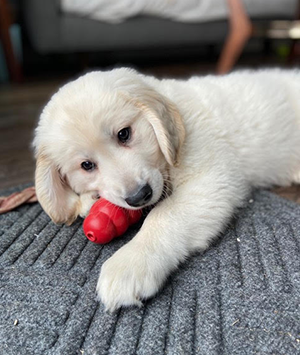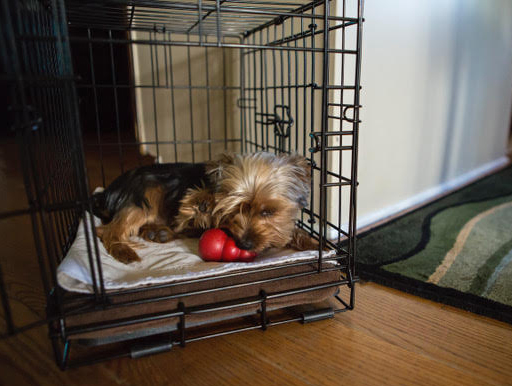We all need our own happy place—including Rover
Being able to remain apart from their pet parent and not panicking is a wonderful trait in a dog. But so many dogs can’t be confined or left alone. Sometimes, dogs need to be confined because they are aggressive toward unfamiliar people and can’t interact with them. Others are destroying the owner’s home when alone. Some dogs are not used to the new baby and are not ready to interact with the little one yet, to name a few reasons. Creating a happy space is important.
Some of these dogs were never trained as a puppy to accept confinement and appreciate alone time. Others were not able to be confined as a puppy because they reacted so severely that the owner just gave up. And some others have made a negative association with the crate.
Confinement training is a useful skill for your dog
Confinement training is a necessary skill for every puppy. This skill teaches your dog that she can be away from you, and it doesn’t have to be stressful. It can even be fun and rewarding. This is such a valuable and necessary lesson. We teach our kids these kinds of lessons, don’t we? If we have parented right, it is easier for our child to accept being away from us on their first days of school than it is for us to initially accept it! This is the same lesson for your pup.
There are lots of times when you might want to confine your puppy. You might confine her to keep her safe until you know that she will not hurt herself when she is alone; prepare her for stays at the veterinarian’s office; housetrain her; keep her from escaping while someone is working in your home; and travel by plane, train, and automobile in safety and comfort. Confinement areas, whether they are crates, travel bags or exercise pens give your dog a cozy place of her own to enjoy her bones and other goodies without anyone bothering her. Shouldn’t we all be so lucky—to have a place that means peace and quiet?

A stuffed food toy is an invaluable tool.
Here is how to begin
The area where you choose to confine your dog is not as important as what you do to help your dog enjoy being there. Start by feeding your pup (or dog) her meals in her confinement space so that she understands that good things happen there. Secretly scatter treats in that area each day so that when she wanders into that space, she will get a wonderful surprise. Give her any new toys, bones, or chewies in that space as well. Everything good comes from her special place.
Once daily, confine your dog to her special area for a couple of minutes with something great like a food toy stuffed with canned food when you are home. When she has finished it and before she gets upset, remove her from her confinement area. Better yet, for the first few days, secure the food toy to the back of the crate and leave the door open. This gives her a choice to stay without her initially feeling trapped. After a few days of her happily ignoring the normal routine of the house around her and settling down with her food toy, begin to close the door to her crate or confinement area.

Create an inviting and safe space in the crate
You begin this training when you are home, which will help her to understand that the confinement area is not always associated with your departure. If she barks for a short period of time when you begin to close the door, completely ignore her. Don’t call out to her to comfort her or yell at her to punish her. Just ignore her. If she barks for more than 10 minutes and you left her with something incredible to chew on, she may have Confinement Anxiety and these puppies cannot be crated or even confined. Sometimes it is difficult to separate the pups who have learned that a crate is a bad place because it is associated with a traumatic event like the owner’s departure or a thunderstorm and the pups that have Confinement Anxiety. Dogs with Confinement Anxiety exhibit panic when confined starting in puppyhood. They don’t just bark for attention, they cry for hours, paw at the crate, and salivate all over themselves. This is fearful and phobic behavior, not your dog being naught. Punishment will just make the behavior worse by creating even more stress for your dog.
For these dogs, a larger confinement area closed off with a baby gate instead of a closed door is a good place to start. These puppies need lots of rewards for accepting confinement without the owner by very slowly increasing the length of time. Then, as the puppy becomes conditioned to stay in her place, the space size can be decreased. Realistically, most of these dogs will not ever be able to be crated, but they can learn to be confined happily.
Be sure that this is a safe space for your pet. When your dog is inside the crate, the kids should be instructed to leave her alone and not bother her while she is resting or working on toys. It should not be used when you’re angry with your pet as a way to punish her. The crate or pen is her sanctuary space.
Confinement is not cruel. It is a gift to your dog. It is the gift of independence and security. It is the understanding that she will be okay, even if she is not with you. It is also a gift to you!

